HackMotion golf gives you the opportunity to master your full swing, pitching and putting. Align your feel with real using the HackMotion wrist sensor. Let’s take a look.
This is the 2nd in a series of articles on “Feel vs Real” in golf.
I would recommend HackMotion Golf.. ★★★★★
I initially bought this device as a putting training aid, but have since gained appreciation for it’s value for full swings as well.
This is a pro level device.
However, there are several options when you purchase it.
Those are the Core, Plus and Pro options.
From HackMotion:
Core: For players who want to improve clubface control and full swing consistency by optimizing wrist angles.
Plus: Work on your whole game by optimizing both the full swing and putting. Reach your peak performance.
Pro: All the wrist data, tour data and analytics for both hands in the ultimate feature package.
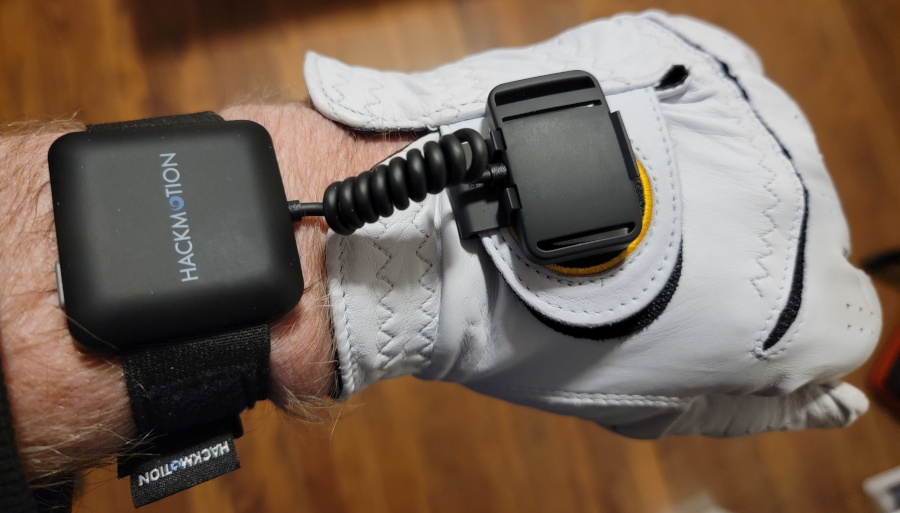
I use the strap when I putt. I don’t wear a glove then.
Note: Calibrate the device by holding your hand and arm level. Select start in the app and then In Position when your arm is level. Then repeat at 45 degrees. You just follow the on screen instructions.
It’s easy to do and you do not have to recalibrate unless you shut off the device.
What’s in the box?
- Wrist Sensor
- USB-C charging cable
- Straps
- Glove attachment
- User Manual
- Warranty Card
It does not come with a carrying case.
Why did I buy HackMotion golf?
I’ve been watching videos about this product for some time.
What caught my attention were videos by David Orr who is a putting specialist. He is widely regarded as one of the best putting specialists in the world.
I wanted to be able to measure what my wrists were doing during my putting stroke. It’s extremely hard to see this with a video camera.
HackMotion sensors give you real time feedback and audio feedback via your smartphone or tablet. It’s compatible with IOS and Android devices.
I have several putting mats and a putting simulator for indoor practice year round. I do not have a full swing simulator.
The good news is that this can be used with or without hitting a golf ball for full swings or pitching. This is important to me. Now, I can practice in my living room.
HackMotion has some great videos online to explain why and how to use the device.
What does it measure?
Without taking a deep dive here, it measures your wrist motion for your full swing, pitching or putting stroke.
In short, being on the correct plane with your swing or putt helps square up the club face at impact.
I ordered the PLUS version right away because that is the first option that included putting data. After I received the device, I upgraded to the PRO version which gives you all the putting data and a lot more swing data.
Here is their site with much more info on each HackMotion option.
Core:
- Wrist flexion/extension movement and clubface control for consistency
Plus:
- Wrist flexion/extension movement and clubface control for consistency
- Wrist flexion/extension and radial/ulnar movement for Putting
Pro:
- Wrist flexion/extension movement and clubface control for consistency
- Wrist flexion/extension and radial/ulnar movement for Putting
- Advanced wrist flexion/extension, ulnar/radial, and rotation movement analysis for full swing.
Page with HackMotion feature sets
Drills
With some data collection devices or improvement aids, you don’t always get advice on fixing things.
You get the data with definitions, but no much coaching.
HackMotion golf has a “drills” option that walks you through maintaining the proper backswing and follow through for full swings.
In other words, wrist position at address, top, and impact. There are audible sounds that play through the app letting you know you are in the correct position.
There are audible tones for consistent putting ranges, but no drills. They need to add more help on putting.
Having an explanation on how to fix things is critical in using devices without a coach.
I do not have easy access to any coach. Let alone someone that uses HackMotion during instruction.
Example: I have one device that tells me I’m adding 2 degrees of loft putting. This device tells me my position at impact is adding loft. Why am I adding loft?
It could be I’m playing the ball too far forward, flipping slightly with my trail hand or my putter has to much loft for my stroke. I need to go for a lesson with Sam Putt Lab or the Quintic putting analysis system.
The good news is I’m putting better than I ever have.
Conclusion
Is this device for everyone? Probably not.
I wouldn’t expect everyone to figure out what flexion, extension, radial, ulnar and rotation mean in wrist movement.
They do make things easier with audible tones.
You can set up audible tones to let you know when you are in the correct position or within the suggested limits. You can also change the limits to fit your swing and tighten it up over time.
It’s really measuring the address position, backstroke or backswing and impact. HackMotion also measures rotation and timing.
Your hands are connected to the club. You are measuring what they doing during your swing or putt.
While they give you suggested ranges, not everyone is the same.
The numbers can change based on how you grip the club, etc.
They key in my mind is to be consistent and work toward tightening things up to control the club face at impact.
Putting is a bit different.
For putts 5 feet and under, there is little or no wrist movement.
For longer putts you will have to load and release the putter creating more movement.
If you want to set higher goals, there is a compare feature. It allows you to compare your data to that of professional golfers.
Photos of initial screens
You choose measure or drills. The examples below are from measuring putt data.
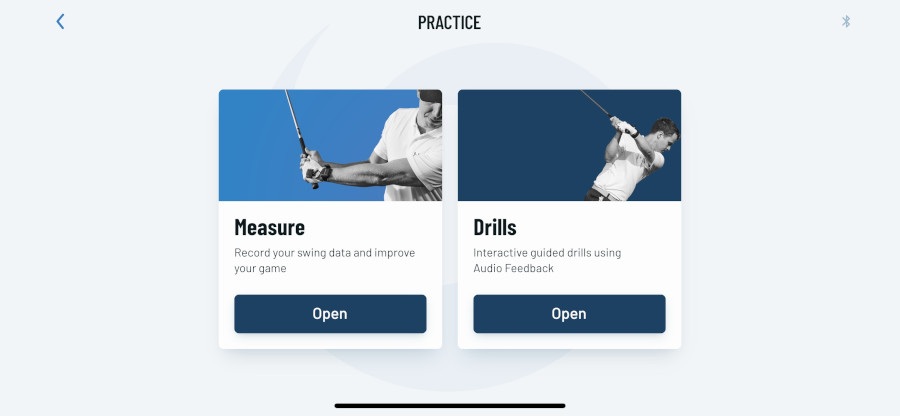
Photos of Full Swing or Putting options
When you select measure these options come up for full swing and putting.
Clubface Control – Practice getting a square clubface and shaft lean
Analysis – Advanced analysis of wrist angles for full swing and pitching
Putting Stability – Practice you wrist stability during putting to make more precise putts.
Analysis – Advanced analysis of wrist angles for putting.

Photos of putting data
These are from several putts that I took after first getting HackMotion golf.
These indicate wrist movement from address, backstroke / top and impact measured in degrees.
The same views are available for full swings.
These were all 5 tooters.
The graph shows I’m pretty good on address and backstroke. The impact data indicates I’m adding loft at impact. Clearly, I need to tighten this up.
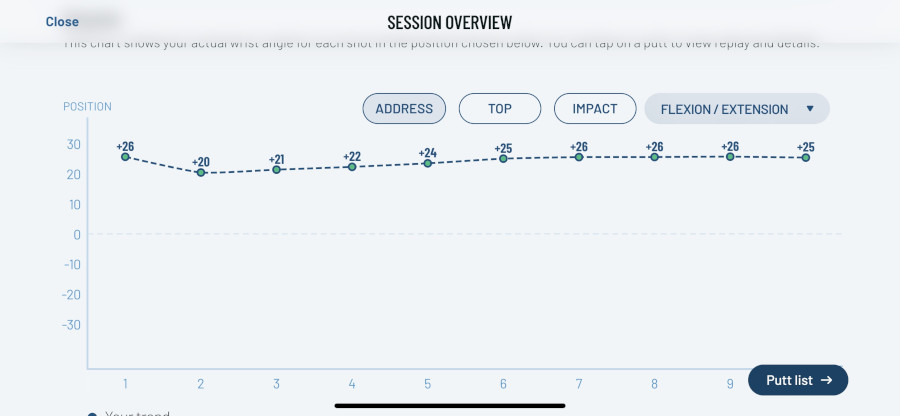

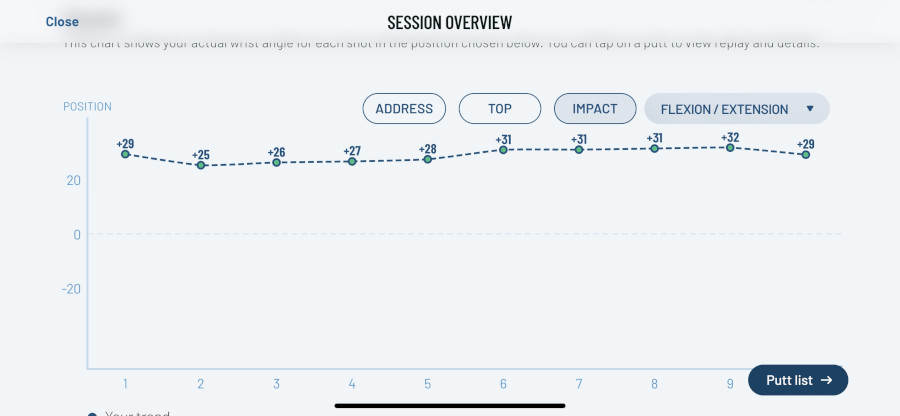
These are two additional views. You can view graphs, tiles, list or replay. The following show a graph and tiles for one putt. You want all the lines on the graph to meet at zero or close to it at impact.
Flexion on this putt increased 4 degrees at impact. The goal is + or – 2 degrees. It looks like I’m flipping my lead hand or steering with my trail hand. Radial / Ulnar deviation is right on.
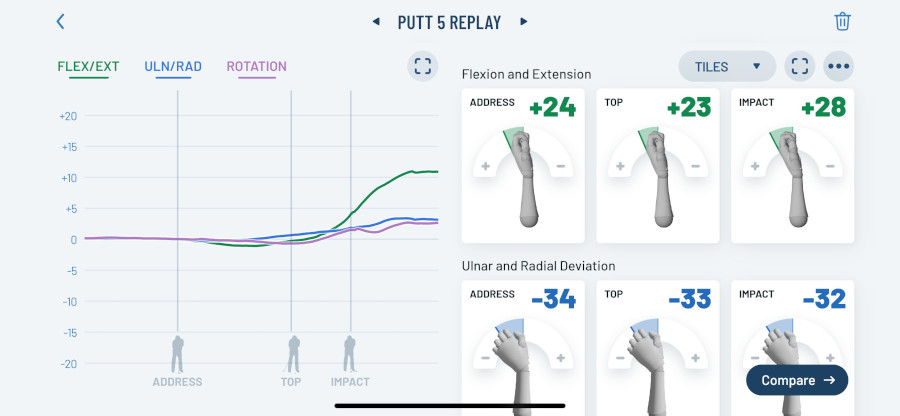
This is the same graph. I just scrolled down to see Rotation and Timing. They both are right on.
Note: Timing on putts should be a 2:1 ratio or 0.60 seconds for the backstroke and 0.30 seconds for the forward stroke.

This is an example of list view. Everything all in one place.
(This example is a partial view of the 10 putts and data. You would scroll down or from side to side.)

Videos
I don’t often link videos, but these are good ones about using HackMotion.
